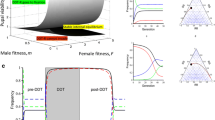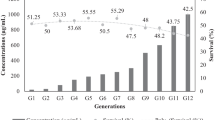Abstract
Resistance at the diazinon-resistance locus (Rop-1) is recessive with respect to fitness. Selection initially occurs at concentrations lower than those required to controlLucilia cuprina. The presence of theRop-1 allele initially disrupted development so that in the absence of diazinon, carriers were at a relative selective disadvantage. Continued use of the chemical, subsequent to resistance evolving, selected a modifier to ameliorate this effect. Modified resistant phenotypes show similar developmental stability and relative fitness to susceptible individuals. Frequency-dependent interactions are observed between resistant and susceptible phenotypes of theRop-1 locus. The interactions are determined by the concentration of diazinon and range from competitive to facilitative. The results are discussed in the context of the contribution insecticide resistance systems can make to the study of general evolutionary phenomena.
Similar content being viewed by others
References
Abedi, Z.H. & A.W.A. Brown, 1960. Development and reversion of DDT-resistance in Aedes aegypti. Can. J. Genet. Cytol. 2: 252–261.
Artavanis-Tsakonas, S., 1988. The molecular biology of the Notch locus and the fine tuning of differentiation in Drosophila. Trends in Genetics 4: 95–101.
Ayala, F.J. & C.A. Campbell, 1974. Frequency-dependent selection. Ann. Rev. Ecol. System. 5: 115–138.
Castro, J.A., L.M. Botella & J.L. Mensua, 1986. Effect of conditioned media on three genotypes of Drosophila melanogaster: physical, chemical and biological aspects. Arch. Insect. Biochem. Physiol. 3: 485–497.
Clarke, B., 1975. The contribution of ecological genetics to evolutionary theory: detecting the direct effects of natural selection on particular polymorphic loci. Genetics 79: 101–113.
Clarke, B.C., 1979. The evolution of genetic diversity. Proc. Roy. Soc. Lond. B. 205: 453–474.
Clarke, G.M. & J.A. McKenzie, 1987. Developmental stability of insecticide resistant phenotypes in blowfly; a result of canalizing natural selection. Nature 325: 345–346.
Clarke, G.M. & L.J. McKenzie, 1992. Fluctuating asymmetry as a quality control indicator for insect mass rearing processes. J. Econ. Entomol. (In press).
Clarke, G.M., B.P. Oldroyd & P. Hunt, 1992. The genetic basis of developmental stability in Apis mellifera: heterozygosity versus genic balance. Evolution. 46: 753–762.
Crow, J.F., 1957. Genetics of insecticide resistance to chemicals. Ann. Rev. Entomol. 2: 227–246.
Daly, J.C., J.H. Fisk & N.W. Forrester, 1988. Selective mortality in field trials between strains of Heliothis armigera (Lepidoptera: Nocturidae) resistant and susceptible to pyrethroids: functional dominance of resistance and age class. J. Econ. Entomol. 81: 1000–1007.
Davies, A.G., P. Batterham & J.A. McKenzie, 1992. Fatal association between dieldrin-resistant and susceptible Australian sheep blowflies, Lucilia cuprina. Proc. Roy. Soc. Lond. B. 247: 125–129.
Denholm, I. & M.W. Rowland, 1992. Tactics for managing pesticide resistance in arthropods. Ann. Rev. Entomol. 37: 91–112.
Georghiou, G.P., 1972. The evolution of resistance to pesticides. Ann. Rev. Ecol. System. 3: 133–168.
Georghiou, G.P. & C.E. Taylor, 1977. Operational influences in the evolution of insecticide resistance. J. Econ. Entomol. 70: 653–658.
Haj-Ahmed, Y. & D.A. Hickey, 1982. A molecular explanation of frequency-dependent selection in Drosophila. Nature 299: 350–352.
Hoffmann, A.A. & P.A. Parsons, 1991. Evolutionary genetics and environmental stress. Oxford University Press, Oxford.
Houpt, D.R., J.C. Pursey & R.A. Morton, 1988. Genes controling malathion resistance in a laboratory-selected population of Drosophila melanogaster. Genome 30: 844–853.
Hughes, P.B. & A.L. Devonshire, 1982. The biochemical basis of resistance to organophosphorus insecticides in the sheep blowfly, Lucilia cuprina. Pestic. Biochem. Physiol. 18: 289–297.
Hughes, P.B. & J.A. McKenzie, 1987. Insecticide resistance in the Australian sheep blowfly, Lucilia cuprina: speculation, science and strategies, pp. 162–177. In: Combating resistance to Xenobiotics. Biological and chemical approaches, edited by M.G. Ford, D.W. Holloman, B.P.S. Khambay and R.M. Sawicki, Ellis Horwood, Chichester.
Hughes, P.B., P.E. Green & K.G. Reichmann, 1984. Specific resistance to malathion in laboratory and field populations of the Australian sheep blowfly Lucilia cuprina (Diptera: Calliphoridae). J. Econ. Entomol. 77: 1400–1404.
Kojima, K. & S.L. Huang, 1972. Effects of population density on frequency-dependent selection in the esterase-6 locus of Drosophila melanogaster. Evolution 26: 313–321.
Leary, R.F. & F.W. Allendorf, 1989. Fluctuating asymmetry as an indicator of stress: implications for conservation biology. Trends Ecol. Evol. 4: 214–217.
Lewontin, R.C., 1991. Twenty-five years ago in Genetics: electrophoresis in the development of evolutionary genetics: milestone or millstone? Genetics 128: 657–662.
Mallet, J., 1989. The evolution of insecticide resistance: have the insects won? Trends Ecol. Evol. 4: 336–340.
Markow, T.A. & J.P. Ricker, 1991. Developmental stability in hybrids between the sibling species pair, Drosophila melanogaster and Drosophila simulans. Genetica 84: 115–121.
Maynard Smith, J., R. Burian, S. Kauffman, P. Alberch, J. Campbell, B. Goodwin, R. Lande, D. Raup & L. Wolpert, 1985. Developmental constraints and evolution. Quart. Rev. Biol. 60: 266–287.
McKenzie, J.A., 1985. Genetics of resistance to chemotherapeutic agents, pp. 89–95. In: Resistance in nematodes to anthelmintic drugs, edited by N. Anderson and P.J. Waller, CSIRO Div. Animal Health and Australian Wool Corporation, Sydney.
McKenzie, J.A., 1987. Insecticide resistance in the Australian sheep blowfly-messages for pesticide usage. Chem. Ind. 8: 266–269.
McKenzie, J.A. & G.M. Clarke, 1988. Diazinon resistance, fluctuating asymmetry and fitness in the Australian sheep blow-fly, Lucilia cuprina. Genetics 120: 213–220.
McKenzie, J.A. & A.Y. Game, 1987. Diazinon resistance in Lucilia cuprina; mapping of a fitness modifier. Heredity 59: 381–391.
McKenzie, J.A. & J.C. Fegent, 1988. Interaction between genotypes at the diazinon-resistance locus of the Australian sheep blowfly, Lucilia cuprina. Facilitation of development of susceptible genotypes. Evolution 42: 1159–1165.
McKenzie, J.A. & M.J. Whitten, 1982. Selection for resistance in the Australian sheep blowfly, Lucilia cuprina. Experientia 38: 84–85.
McKenzie, J.A., P. Batterham & L. Baker, 1990. Fitness and asymmetry modification as an evolutionary process. A study in the Australian sheep blowfly, Lucilia cuprina and Drosophila melanogaster, pp. 57–73. In: Ecological and evolutionary genetics of Drosophila, edited by J.S.F. Barker, W.T. Starmer and R.J. MacIntyre, Plenum Press, New York.
McKenzie, J.A., J.M. Dearn & M.J. Whitten, 1980. Genetic basis of resistance to diazinon in Victorian populations of the Australian sheep blowfly, Lucilia cuprina. Aust. J. Biol. Sci. 33: 85–95.
McKenzie, J.A., J.C. Fegent & G. Weller, 1986. Frequency-dependent selection at the diazinon resistance locus of the Australian sheep blowfly, Lucilia cuprina. Heredity 56: 373–380.
McKenzie, J.A., A.G. Parker, & J.L. Yen, 1992. Polygenic and single gene responses to selection for resistance to diazinon in Lucilia cuprina. Genetics 130: 613–620.
McKenzie, J.A., M.J. Whitten & M.A. Adena, 1982. The effect of genetic background on the fitness of diazinon resistance genotypes of the Australian sheep blowfly, Lucilia cuprina. Heredity 49: 1–9.
Muggleton, J., 1986. Selection for malathion resistance on Oryzaephilus surinamensis (L). (Coleoptera: Silvanidae): fitness values of resistant and susceptible phenotypes and their inclusion in a general model describing the spread of resistance. Bull. Ent. Res. 76: 469–480.
National Research Council, 1986. Pesticide resistance: strategies and tactics for management, National Academy Press, Washington.
Palmer, A.R. & C. Strobeck, 1986. Fluctuating asymmetry: measurement, analysis, patterns. Ann. Rev. Ecol. System. 17: 391–421.
Parker, A.G., R.J. Russell, A.C. Delves & J.G. Oakeshott, 1991. Biochemistry and physiology of esterases in organophosphate-susceptible and-resistant strains of the Australian sheep blowfly, Lucilia cuprina. Pest. Biochem. Physiol. 41: 305–318.
Parsons, P.A., 1983. The evolutionary biology of colonizing species, Cambridge University Press, Cambridge.
Parsons, P.A., 1990. Fluctuating asymmetry: an epigenetic measure of stress. Biol. Rev. 65: 131–145.
Parsons, P.A., 1991: Evolutionary rates: stress and species boundaries. Ann. Rev. Ecol. System. 22: 1–18.
Raftos, D.A., 1986. The biochemical basis of malathion resistance in the Australian sheep blowfly, Lucilia cuprina. Pestic. Biochem. Physiol. 26: 302–309.
Raftos, D.A. & P.B. Hughes, 1986. Genetic basis of a specific resistance to malathion in the Australian sheep blowfly, Lucilia cuprina (Diptera: Calliphoridae). J. Econ. Ent. 79: 553–557.
Roush, R.T., 1993. Absence of coadaptation of fitness with DDT-resistance in Aedes aegypti (Diptera: Culicidae). J. Econ. Entomol. (In press).
Roush, R.T. & J.C. Daly, 1990. The role of population genetics in resistance research and management, pp. 97–152. In: Pesticide resistance in arthropods, edited by R.T. Roush and B.E. Tabashnik, Chapman and Hall, New York.
Roush, R.T. & J.A. McKenzie, 1987. Ecological genetics of insecticide and acaricide resistance. Ann. Rev. Ent. 32: 361–380.
Roush, R.T. & B.E. Tabashnik (editors), 1990. Pesticide resistance in arthropods, Chapman and Hall, New York.
Russell, R.J., M.M. Dumancic, G.G. Foster, G.L. Weller, M.J. Healy & J.G. Oakeshott, 1990. Insecticide resistance as a model system for studying molecular evolution, pp. 293–314. In: Ecological and evolutionary genetics of Drosophila, edited by J.S.F. Barker, W.T. Starmer and R.J. MacIntyre, Plenum Press, New York.
Scharloo, W., 1991. Canalization: genetic and developmental aspects. Ann. Rev. Ecol. System. 22: 65–93.
Simpson, P., 1990. Notch and the choice of cell fate in Drosophila neuroepithelium. Trends in Genetics 6: 343–345.
Singh, R.S. & R.A. Morton, 1981. Selection for malathion-resistance in Drosophila melanogaster. Can. J. Genet. Cytol. 23: 355–369.
Taylor, C.E. & G.P. Georghiou, 1979. Suppression of insecticide resistance by alteration of gene dominance and migration. J. Econ. Entomol. 72: 105–109.
Templeton, A.R., H. Hollocher, S. Lawler & J.S. Johnston, 1990. The ecological genetics of abnormal abdomen in Drosophila mercatorium, pp. 17–35. In: Ecological and evolutionary genetics of Drosophila, edited by J.S.F. Barker, W.T. Starmer and R.J. MacIntyre, Plenum Press, New York.
Van Valen, L., 1962. A study of fluctuating asymmetry. Evolution 16: 125–142.
Wallace, B., 1975. Hard and soft selection re-visited. Evolution 29: 465–473.
Whitten, M.J. & J.A. McKenzie, 1982. The genetic basis for pesticide resistance, pp. 1–16. In: Proceedings 3rd Australasian conference of grassland invertebrates, edited by K.E. Lee, South Australian Govt. Printer, Adelaide.
Whitten, M.J., J.M. Dearn & J.A. McKenzie, 1980. Field studies on insecticide resistance in the Australian sheep blowfly, Lucilia cuprina. Aust. J. Biol. Sci. 33: 725–735.
Wood, R.J. & J.A. Bishop, 1981. Insecticide resistance: populations and evolution, pp. 97–127. In: Genetic consequences of man made change, edited by J.A. Bishop and L.M. Cook, Academic Press, New York.
Author information
Authors and Affiliations
Rights and permissions
About this article
Cite this article
McKenzie, J.A. Measuring fitness and intergenic interactions: The evolution of resistance to diazinon inLucilia cuprina . Genetica 90, 227–237 (1993). https://doi.org/10.1007/BF01435042
Received:
Accepted:
Issue Date:
DOI: https://doi.org/10.1007/BF01435042




